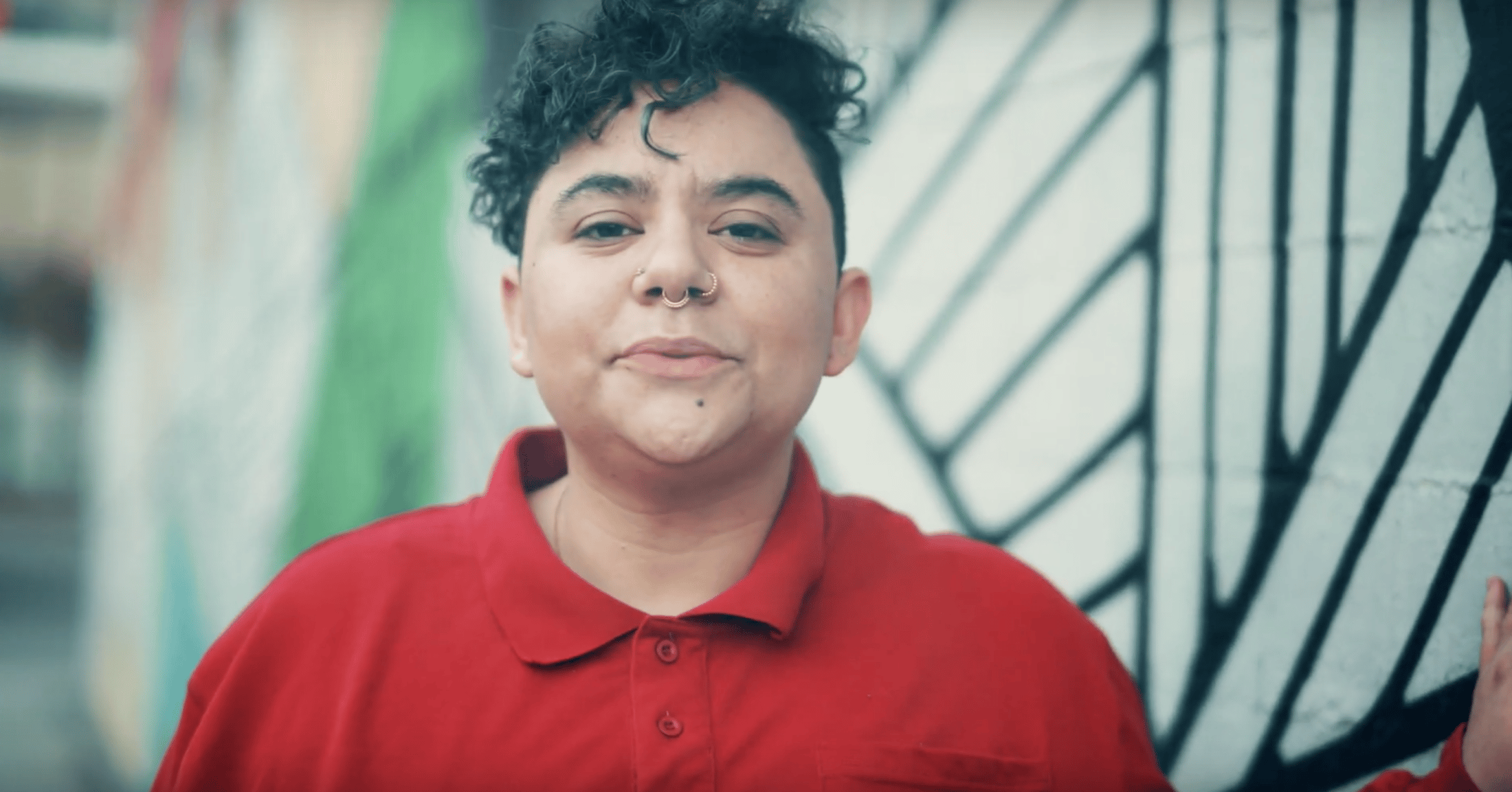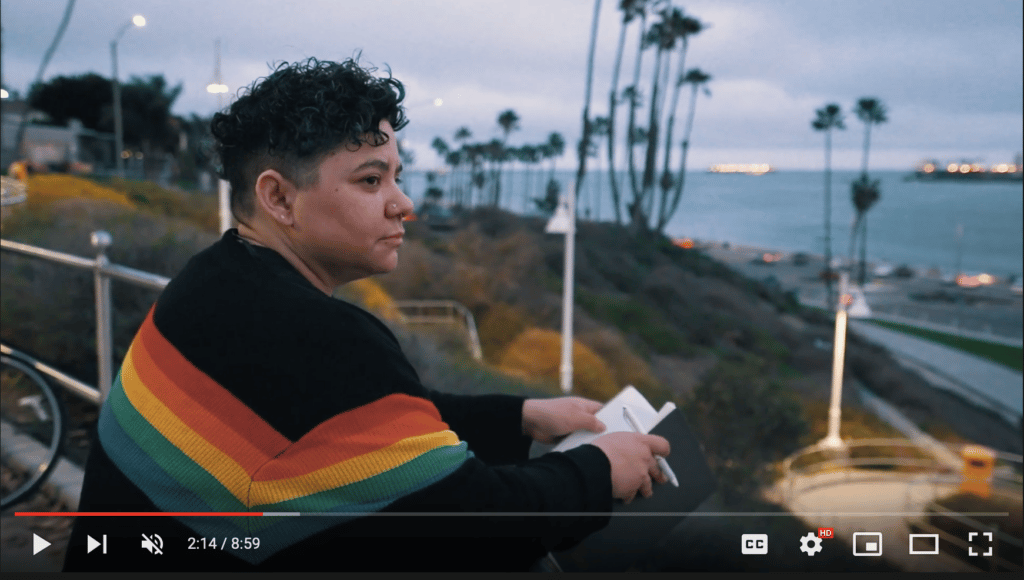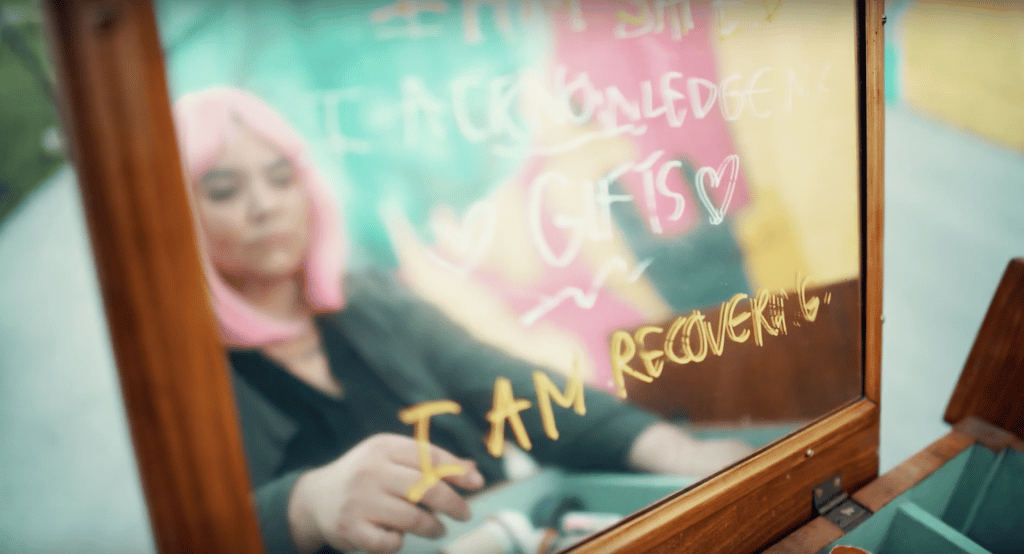
Earlier this year, Jess Torres (Solís Policy Institute class of 2019) was asked to share a spoken word piece at a virtual gala for, as they put it, “a pretty rad human trafficking coalition.” I watched Jess’ video and was blown away by the power and passion contained within. I spoke to Jess about their process and how art can be a profound form of activism. What follows is a lightly edited version of our conversation.
Watch Fire Flower – a remarkable work of art that prioritizes joy, self-preservation, and wellness. Be advised of the themes of human trafficking, child abuse, and transphobia.
Jess withheld nothing, and made it very clear: “This is not my “resilient” story. At the end of the day, I made it happen and took my power back and reclaimed my agency. No one saved me. I saved myself.”
How The Video Happened
This video was the first time I’d ever done anything like this. I write and have kept journals most of my life, and my roots in oral tradition have made a poet and storyteller out of me. So when this anti-trafficking organization was hosting a gala and they didn’t want a keynote speaker, they wanted someone to make art – I was essentially volun-told it would be me!
I often incorporate spoken word into many of my keynote speeches but it was never the focus of my participation. This, on top of my meager open mic experience, made me a bit apprehensive so I recommended five other seasoned artists, considering the fact that I had never made a video before. I also had a two-week deadline. Two weeks to find a videographer, editor, write a poem, memorize it and record it? Never going to happen. I had pulled reckless abandon outta thin air before but this was going to take like, audacity.
The E.D. who had heard me speak before was persistent and insisted it could be done and that I would be the one to do it. She almost provoked me to be honest, like…okay mic drop since when did you get so reserved? Hmm, standsupfightsback (my email address) are you lowkey sitting down and tapping out, it was a great strategy, because it allowed me to both school her on my freshly renewed commitment to setting and holding boundaries and an opportunity to wax philosophically about my breakup with grind culture. She totally understood and backed off. But obviously when you tell me I can’t do something…. argh. That night, my child and I went to the grocery store, we were out of everything, not because I couldn’t afford to go to the store but because I had taken a few consulting gigs and I hadn’t had the time to shop so we were ordering out way too much. Since the pandemic started I have been getting groceries delivered but my daughter wanted to linger up and down the aisles to switch up her school snacks. When the cashier rang up the items the total was nearly $500….and it wasn’t terrifying. I knew I could cover all my bills and rent, my daughter’s tuition had already been processed for the month and I had the comfort of a few lines of credit and a tiny but respectable savings. It hit me so hard at that moment…whose life is this? How did I get here? When did I get here? It was like a portal unlocked so I got home and wrote about 16 pages. I needed to map it out and weave it all together — the collective landscape, what was left behind, what was inherited, what was chosen, what was personal and universal. Loss, pain, tragedy and uncertainty purposely and precariously balanced with concepts of transformation, resilience, hope, declarations of power and the illumination of a…. future? I read it to the E.D. who’s theme for the gala was “economic empowerment” and she cried, she said this was the way to bridge people’s understanding and knowledge bases, a remedy that could be shared.
Who Made The Video
I made the video with two videographers (Joanna Friedman (thehopedealers.tv) and Natalie Perez) drafted up the concepts, and shot it over the weekend.
That shoplifting scene in the store? I had every Target employee with a child disclosing their “crimes’ ‘ of survival that night to which I would reply, do you know what the term “social construct” means? One dude said, “It means if Covid doesn’t get us starvation will.” The employees were really curious, they kept asking what my movie was about and I promised the security guard I wasn’t really stealing, I was recreating a time in my life where this — basic survival, diversion court, jail, postpartum depression and an abusive relationship after being sex and labor trafficked (so my child and I had a roof over heads), were the only illusions of choice I had. He said, “Been there, I wouldn’t say anything if you did take it, just be smooth with it. Any enforcement of this bullshit is against god, no baby should go hungry, no parent should be forced by life’s conditions to commit a crime to feed them, this world is fucked up for criminalizing the poverty it creates and imposes.” A sermon.
Hunger is at chronic levels since the pandemic began. They didn’t need to understand what a “social construct” was to know that living wages were nowhere in sight. One woman whispered to me, “No shame love, god understands, it’s Jeff Bezos who shouldn’t sleep at night, not us.” I don’t really know who or what they know God to be but I thanked the kindness of this Spirit and their unanimous exoneration.
That experience was sort of profound. This thing we were all secretly and collectively carrying guilt about…the weight of it had finally reallocated to its rightful owner. When folks from all walks of life make art, new perspectives and connectivity can emerge. When people from diverse backgrounds immerse themselves in those perspectives we grow more connected to one another, more empathetic.
Who Watched The Video
It was wild– a friend who works in media sent it to Oprah and she watched the whole thing and said it was “Powerful” and quoted words from the beginning and the end of the poem.
Who watches nine minutes of anything these days? I thought maybe I had overdone it. Did I mention cutting 8 pages? My lifelong modus operandi…the inability to” keep it short”? My swirl of sentimentality after the grocery store had me scanning the annals of time, trying not to remember, then flooding? It is here where I came to the statement: “reclaiming the body begins with rewriting the body’s story”.
Much of the feedback I received was survivors of all kinds of sexual violence disclosing their experiences of abuse, expressing that my work had helped them find the courage to document their own narratives. Others were folks struggling with their mental health who found inspiration in sticking it out “if I could”. It was as if I had uncovered or unlocked the doorway to an immersive atmosphere, inviting others to safely engage in their own personal discoveries and therapeutic process. Many of the youth I mentor from the LA county CSEC unit text me ‘YOU SNAPPED SNAPPED SNAAAAAAPED” throughout the week, I’m still not 100% sure what that means but Imma take the fire emojis as a compliment. And I got a standing ovation at the gala. That being said, the other recurring theme was about how I managed to weave in system’s analysis. This is how I reclaimed the story and reframed the memories and the resulting thoughts and feelings surrounding them.
I was really happy with this feedback because what I didn’t want to do was write a trauma narrative that was a trauma zoo, or something that generated pity. I wanted to discover and reveal the interconnection of our cultural sediments. The individual pieces layered with personal and universal meaning, inviting the viewer to engage in the conversation. Even though I did this over a weekend with limited time to work through all of the pieces I still hoped it would be more of a poetic investigation on the concepts of relationships, ancestry, cultural identity, struggle, sovereignty….and perhaps a guide for those suffering on how to be your own deliverance. While releasing the distress of holding ourselves to a linear progression, claiming the peace of knowing there is no end, only new flavors, new things.
And, to be clear, this is just one story about who I am, it is not “the story”.
I am free to tell another at any time.
Furthermore, it’s important to remember that everyone’s care and access needs are distinct. And that it will always take more than one person to collectively confront oppressive power. , especially for those in the margins. Only through collective understanding of the obstacles we face and staying attuned to each other’s needs will we be able to build the affinity necessary for change. Our work is to design ways of coming together that become an example of the future we desire, a place that leaves no one behind.
I was truly astounded by the amount of people who found it worth watching though…. and the scope of the feedback was also on a fairly large scale. From colleagues to perfect strangers to Oprah, and this month it was screened at the South Central Film Festival.
On Making The Personal Public
Even though this was a commissioned piece, it was still a very intimate and personal experience. I didn’t fully grasp at the time, the spectrum this medium was capable of reaching, how it could live beyond this moment and that it could be seen, heard, received by, well, anyone with access to the internet
Art should always be part of our work, because art can live on past the experience of advocacy – it has the power to endure and permeate beyond time and place, it can stay relevant for those newly engaging with it, AND it intersects and interacts with people you’d never think it would – (like…my family after they saw it on YouTube, oh what joy).
Furthermore, everyone deserves to see themselves reflected in the arts – to see their experiences reflected in every space – from autonomous neighborhood cultural centers to major institutions.
On The Power of Art
What can art do in the world? It can be proactive advocacy.
It can foster a supportive environment to research and develop ideas and create opportunities to work together. It can build relationships with decision makers by bringing alternative forms of wisdom, finding new ways to solve problems and interrupting the culture of white supremacy by cultivating belonging. Sometimes there is no understanding of shared equity, but we can use arts to fill gaps in operational culture and transform old ways of thinking.
Partnerships that merge municipalities’ and artists allow us to address issues in new ways; and aspire to greater goals in service of the public. Some projects culminate in visible art products while others are internally facing within an agency and the reflexive process is the outcome. An art process, such as creative placemaking or place keeping and social practice art can support community-based initiatives and exist as a community development process that navigates between public, private, and nonprofit funding to shape projects using cultural strategies. The distribution of power between community, artist and agency, specifically who created the conditions for the work, who defines goals, who controls the outputs is important to keep in mind.
Artists and governments have a very different way of working in the world and talking about the same thing with different languages. This is reflective of systemic differences. Making art offers an opportunity for reflection and learning in both the governmental space and community space, by bridging knowledge gaps. When we’re having conversations about how creative strategists strive for equity goals and support the work of community organizers, we are sharing power.
Understanding the needs of marginalized peoples can become more of a reflective process when you’re faced with art. The information can be received more fluidly and foster cultural empathy and thus play a crucial role in sustaining thriving communities.
It goes beyond reactive advocacy (talking to legislators, for instance.) It gives you the potential to engage with millions of people. Art may be non-traditional advocacy, but it’s advocacy just the same.
When Things Were Hard, What Kept Jess Going
I’ve spent many seasons of life stuck in unbreakable cycles, I cried but I didn’t quit.
We can’t avoid seasons of darkness. Sometimes the rage is scared and other times it’s misleading. Either way, we are forced to dance with the devil or wrestle with the demons. We all have to walk through the fire (sometimes over and over again). But when we choose to keep going, step by step, we transform into the person capable of fulfilling our divine purpose.
So shout out to everybody digging deep to find their last bit of hope, things are not always easy but we have to remind ourselves that suffering is not our destiny, it is manmade, it is systemic. We were all created to thrive on this planet. We have to hold this knowledge and keep the promises we make to ourselves and each other, honor the vision(s) we have, and remind ourselves as many times as we need to that we are not powerless.
The real work has been to forgive myself for every time I thought about giving up on myself. To forgive myself for the moments I let fear and anxiety win. To forgive myself for the times I did not have control over the situation. To forgive myself for the times I forgot or didn’t know my heart was worth my own protection.
I like to focus on what I can control, this grounds me in the present moment and pulls me into a more mindful space, empowering me to think constructively – instead of ruminating. Feeling triggered is considered “negative”, but how can we sit with the information being offered by the wound and use it to understand what work needs to be done in this space? We have to take the time to learn ourselves, confront our limiting beliefs and become really clear about who we are outside of our conditioning/socialization, outside of anyone’s projections or assumptions.
Anyway, my daughter is my forever reason for keeping it moving. For boldly and consistently reaching higher, for embodying the audacity it takes to unapologetically claim what is ours.
Community is second.
Closing Thoughts on The Anti-Trafficking Movement
I have never ending thoughts on this topic!
Impacted people want safety, long-term support and access to resources that help us prevent, avoid, escape and mitigate violence. We want to move past survival. Moving forward, ONLY self-determination should be centered, prevention and services should be funded and the systems that punish survivors and continue cycles of violence should be defunded to invest in community-based care responses, healing and wellness. Breaking down things that oppress and building up things that nourish. It brings me so much hope and relief to think of the possibility of focusing our attention on generative and empowering things without having to pour so much energy into trying to mitigate “rescue”.
All any of us should really be trying to do with our time, energy and talent is remove the obstacles to people being able to take care of themselves.
This movement has a savior-based foundation. They “empower us” just enough to make sure we always have our hand out. Survivors in and out of the trafficking experience don’t have their basic needs met and their traumas are barely, if ever, tended to. So how tf are we supposed to imagine liberation?
I dream of a world where we are all the beneficiaries of reciprocity, a world where we are all flourishing.
Brown Sugar Honey Child
Before we go, allow me to make a shameless plug for, Brown Sugar Honey Child Jess’ body care side hustle officially going LLC next month! Their handcrafted body care products (created with homegrown and traded ingredients) are formulated to support re-connection through traditional medicine and ceremony. Brown Sugar Honey Child partners with a local cultural center, Lora Y Tierra, to provide much needed harm reduction, health education, advocacy, and critical resources to the Long Beach area.
Presently you can find their soaps @ SOAP TRIO | Gifted by FreeFrom. GIFTED by FreeFrom is a social enterprise focused on generating wealth for survivors through entrepreneurship and living wage employment. They envision a world in which all survivors are able to build the wealth and financial security necessary to support their individual, intergenerational, and community healing.

